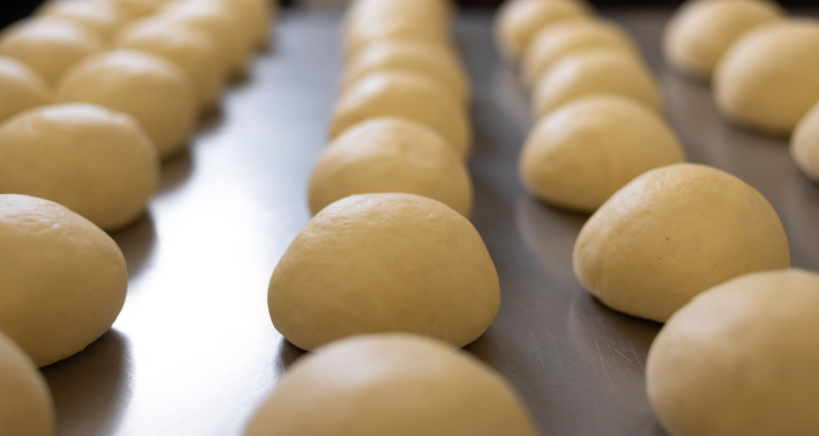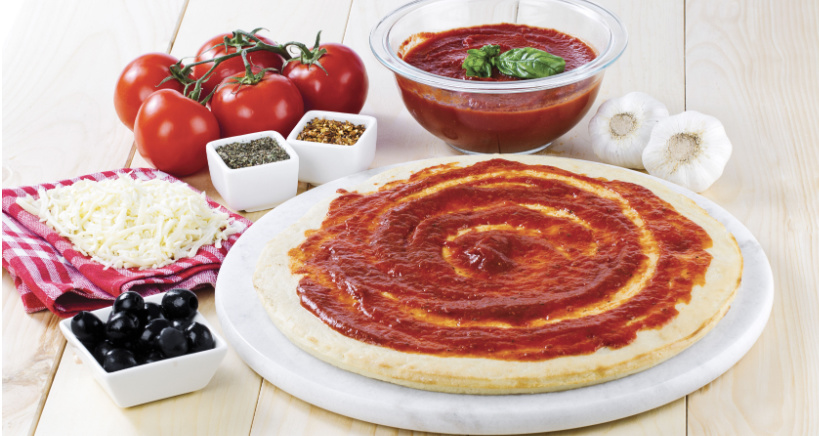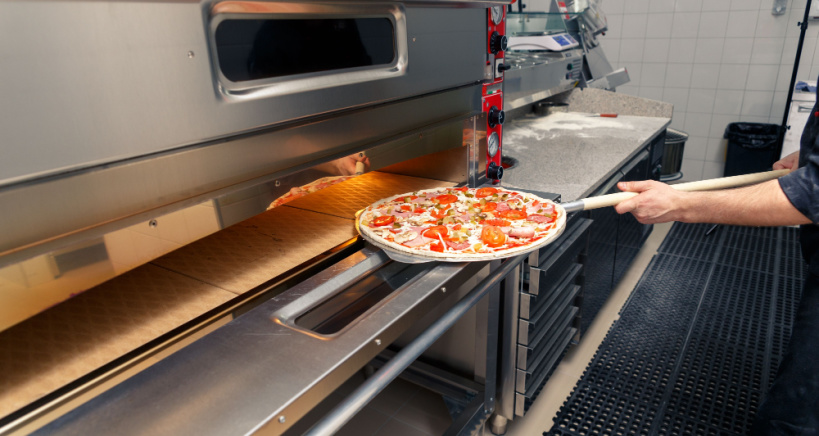
Stand on a random corner in New York City and open your favorite food-delivery app. You can probably find more than a dozen places to order pizza from. But, it wasn’t always like that. Legend has it that Italian immigrant, Gennaro Lombardi, opened the first pizzeria in the United States in 1905. Back then, pizza in America was a niche product, catering mostly to Italian-American immigrants craving the flavors of the old country. Today, just over a century later, the pizza industry is a massive $45 billion dollar business. It is estimated that Americans consume 350 gooey, saucy, cheesy pizza slices every second.
There’s no doubt that pizza is a lucrative, sought after, and growing industry. If you are a restaurateur looking to add a classic New York-style slice or a Neapolitian personal pie to your menu, it’s not difficult to get started. All you need is dough, sauce, toppings, and an oven optimized for baking crispy pizza to perfection. Here’s how to achieve that ideal symphony of flavors, ingredients, and baking techniques that your customers will love.
Dough-lightful Dough
Quality pizza starts with quality dough. To make a New York-style pizza dough, you only need six ingredients for the dough: yeast, water, sugar, olive oil, flour, and salt. Actually, that’s one of the reasons that pizza restaurants tend to have high profit margins; the bulk of the ingredients are inexpensive baking staples.

Of course, there are always ways to upgrade the basic, simple pizza dough. Many customers enjoy the fresh and savory taste of herbed dough. To make an herbed dough, just add a few sprinkles of Italian seasoning into your dry ingredients. Other trendy pizza varieties include whole-wheat and gluten-free pizza, which just require you to swap out the type of flour you use. For most pizza doughs, you will use half the amount of water to flour, while the ratio of the other ingredients will vary.
The Neapolitan pizza (and its close cousin – the margherita pizza) is as authentic Italian as you can get. It’s so authentic that UNESCO has declared it an intangible heritage, and if you live in Naples and want to sell Neapolitian pizza, you need to follow a very specific list of rules and steps. One of those rules is that the dough should be sugar free and fat free, so to bake Neapolitian, leave out the sugar and oil.
Another rule about the Neapolitan is that it must be made with 00 Flour, an Italian flour variety that is extremely finely ground. It’s a must-have for Neapolitan pizza, and you can use it to make any homemade pizza crispier. Walmart, Target, and Whole Foods all stock this flour variety. For other pizza varieties, you can tailor the flour to your personal brand. Using bread flour, which has a higher protein and gluten content, yields a chewier pizza than one with an all-purpose flour base.
Mixing the Dough
Dough mixers are ideal for giving ingredients a good mix, and for developing the gluten. An all-purpose mixer with dough hook attachments will also work. Pour in water, a small amount of sugar (just enough to proof the yeast) and the yeast itself. Stir gently, and let the mixture sit for five minutes or so until the yeast activates and the mixture gets foamy and aromatic. Next, pour in olive oil, salt, and flour and let the mixer do its magic. After the dough becomes combined, you can gradually add more flour until it is dough-like and no longer sticky.
After mixing the dough, let it rise in a warm area for about an hour, until it doubles in size. If you opt for making a thin-crust pizza with a flat bread-ish consistency, don’t let the dough rise for more than 15 minutes. However, even traditional, thick-crust pizza requires a shorter rise than bread and other baked goods, so don’t leave your dough out on the counter for too long. A good strategy for a busy restaurant is to make the dough ahead of time in bulk, cut the risen dough into balls (an approximately 260-gram sized ball makes a 12-inch pizza), let them proof for about 15 minutes in a proofing pan, and then split the balls between deep freezer storage and your refrigerator. Actually, letting the dough chill makes your pizza crustier as well.
Shaping the Dough
You’ve probably seen those videos of chefs throwing the pizza dough in the air to stretch it. And, if you have chefs capable of tossing the dough, go for it. If not, there are easier ways to stretch the dough and get that nice, rounded shape without anything ending up on the floor.
For a New York-style, round, thick-crust pizza, start by covering the flat surface with unbleached flour. Then push gently on the ball of dough, in a down and outward direction, while slowly turning it in a circle. You should end up with a disk-like shape that’s a bit smaller and thicker than you want your finished product to be. Now that you have the basic shape, it’s time to stretch it.
If you aren’t familiar with how to throw the dough with dramatic, Italian flair, you can stretch it by picking up the disk and letting it rest on your fists. Turn it, while gently stretching your arms apart until you hpizzave your flat pizza base. Restaurants processing a large amount of dough may want to invest in a dough roller. These neat machines speed up the time it takes to get a flat, even, pizza base. Chefs will need to flatten their pizza into small discs before feeding them into the machine, which evenly stretches the discs into pie-sized shapes.
Different Pans for Different Pizzas
Depending on the type of pizza you want to make with your dough, you will need to choose the appropriate pizza pan. There are a variety of options:
- Pizza screen: this has a mesh-like structure made of aluminum or stainless steel designed to allow hot air to circulate underneath the pizza, promoting even cooking and a crispy crust. The screen prevents the dough from sticking and can be useful for baking the following types of pizza: thin-crust pizza, cracker-style pizza, tavern-style pizza, and flatbread-style pizza.
- Pizza disk: also known as a pizza stone or baking stone, are preheated in the oven and provide a hot surface for baking pizza, replicating the intense heat of a wood-fired oven. The pizza is placed directly on the heated disk, which helps to create a crispy crust. It is used most commonly to make Neapolitan pizza, artisan pizza, and thin-crust pizza.
- Pizza tray: also called a pizza pan or pizza plate, is a round shallow pan or square deep pan (for Sicilian pie) made of aluminum, steel, or other materials. It features a flat surface with small holes or perforations to allow heat to reach the dough, resulting in a crispy crust. Pizza trays are commonly used for baking thick-crust or deep-dish pizzas.
While some pizza shops may use a variety of pizza trays, disks, and screens to accommodate different pizza styles, others may specialize in specific types of pizza and primarily use certain types of pans.
Making the Perfect Sauce
Here’s an interesting fact about pizza. Historians are pretty sure that Italians have been putting cheese, oil, herbs, and toppings on flatbreads for thousands of years. Tomato-sauce pizza, however, was a more modern invention. Tomatoes are a New World food, which means that they are native to the Americas and weren’t brought to Europe until the 1500’s. Once they made their way onto the Italian focaccia flatbreads, marinara sauce became an essential piece of the pie.

Of course many chefs are familiar with basic marinara sauce. However, when it comes to making the freshest, juiciest pizza sauce, there are additional points to keep in mind. Firstly, it’s tempting to use canned ingredients as the base. But the pizza will taste fresher and more original if you go for fresh tomatoes, garlic, and herbs. To bypass the headache of skinning fresh tomatoes, place them in a pot of boiling water for a few seconds. The goal is to loosen the skin, not to cook it. Move them immediately from the hot water to an ice bath, and the skin should slip off easily. Cut the tomatoes open and remove as many seeds as you can. This ensures a smooth, constituent texture. Then, puree the tomatoes in a high-speed, high-impact blender. Saute fresh garlic and chili, and pour the tomato blend into the saucepan as well. Season to taste with black pepper, fresh oregano, and fresh basil. Always let the sauce cool fully before spreading it on the dough.
The only exception to the fresh-ingredient rule is if you are making a true Neopolitian pizza. A Neapolitian pizza requires San Marzano tomatoes, a specific variety of plum-like tomatoes with a strong, sweet flavor that are only grown in Campania. If you can’t find fresh San Marzano tomatoes, look for a canned variety. (Amazon and Walmart both stock these cans.)
There are so many tasty, popular pizza varieties out there that may use different sauce bases. But, as long as you pick wholesome, ripe, fresh ingredients, your homemade pizza will come out just great.
The Cheese and Toppings
Neapolitan pizzas are always topped with a delicious, savory combination of creamy, fresh mozzarella, aromatic, fresh basil, and decadent olive oil. Even if you plan to make an American-style pizza, which is usually topped with a grated blend of cheeses that sometimes use mozzarella, cheddar, and provolone, among other varieties, adding additional fresh mozzarella is a great way to infuse an additional rich, creamy note to your pie. Besides, you can use the fresh mozzarella in so many other menu items, like salads, caprese sandwiches, and cheese platters.
After the cheese is prepared and you know what toppings you plan to use on your pie, it’s time to ladle them on! Spread the dough on the pizza pan and ladle a small amount of sauce directly onto the middle with a deep, rounded, metal ladle. Be careful not to overdo it. A little sauce goes a long way. Put your ladle, rounded side down, onto the sauce and move it in concentric, spiraling circular motions, while pressing down very gently, in order to cover your pie with sauce. Next, sprinkle or place on the cheese and toppings. Now, your pizza is ready to bake.
Baking the Pizza
A proper oven for cooking authentic, crispy, evenly baked pizza is an important investment. While at-home cooks can get away with using a pizza screen and a countertop pizza oven, commercial operations will need to invest in something more powerful. This is especially important if your establishment plans to produce Neapolitian pizza, which is only baked for three minutes or so, in an oven heated to approximately 800-1,000 degrees. A commercial electric or gas pizza deck oven allows for extremely high temperatures. Many also boast additional features such as multiple decks for cooking several pies simultaneously, customizable programming, tempered glass windows, and halogen lighting.

Some ovens are made with refractory bricks that heat quickly and retain heat for a long time, making pizza baking fast and efficient. If you want something with a more classic look and feel, consider investing in a domed, brick-deck pizza oven. This powerhouse of an oven has a max temperature of 950°, an interior brick deck, customizable programs, a removable door so guests can watch the pizza bake. It also yields 200, 12″ pizzas per hour!
Another option for high-volume settings is a conveyor pizza oven. Here multiple pizzas can be placed on the conveyor belt, the cooking settings input, and the raw pizzas move along the conveyor belt through the oven. After a few minutes, presto – multiple pizzas emerge, cooked uniformly and to perfection. These ovens are also fully customizable and reach about 600 degrees or more. At that temperature, it takes only about 8-15 minutes to cook each pie, depending on crust thickness and how crispy or chewy you like the final product to be. In an 800 – 900 degree oven, baking a pie takes only minutes
Enjoying the Results
. As your pizza is baking, your pizzeria will smell heavenly and your customers will be waiting eagerly to taste your freshly baked pizza pies, dripping with flavor. Don’t forget that a pizza cutter is the best way to cut the pie without mangling it. Another tip is to stock up on fruity, dry wine, like a Chianti or a Pinot Noir, that pairs well with artisanal pizza, for an authentic, fine-dining experience. After your customers taste the quality of a truly authentic pizza, baked-to-perfection, they will never order from Dominos again!
Buon appetito!